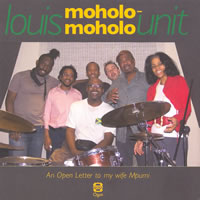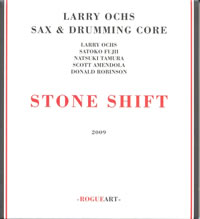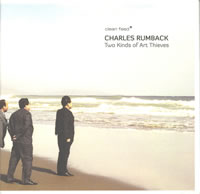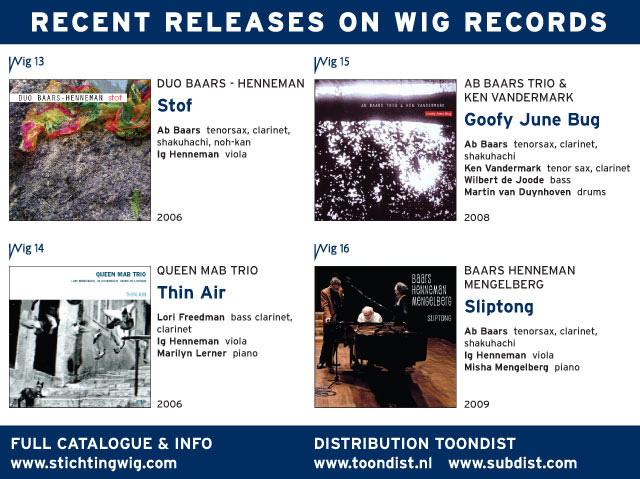Moment's Notice
Reviews of Recent Recordings
(continued)
Dom Minasi String Quartet
Dissonance Makes the Heart Grow Fonder
Konnex 5235
 Since founding his own CDM label in 2001, veteran guitarist Dom Minasi has expressed his singular artistry in a wide range of settings, from his freewheeling 2001 trio tribute to Ellington, Takin' The Duke Out, to the expansive 2006 concept album The Vampire's Revenge, which featured an all-star cast in rotating line-ups. Minasi's Konnex Records debut, Dissonance Makes the Heart Grow Fonder is his eighth recording as a leader in the past decade, and notably, his first in as many years for a label other than his own. Joined by a string trio culled from the aforementioned 2006 session, this is his first dedicated foray into the realm of chamber music.
Since founding his own CDM label in 2001, veteran guitarist Dom Minasi has expressed his singular artistry in a wide range of settings, from his freewheeling 2001 trio tribute to Ellington, Takin' The Duke Out, to the expansive 2006 concept album The Vampire's Revenge, which featured an all-star cast in rotating line-ups. Minasi's Konnex Records debut, Dissonance Makes the Heart Grow Fonder is his eighth recording as a leader in the past decade, and notably, his first in as many years for a label other than his own. Joined by a string trio culled from the aforementioned 2006 session, this is his first dedicated foray into the realm of chamber music.
A former student of composer John Corigliano, Minasi's advanced approach to melody, harmony and rhythm is far from conventional. His spacious yet labyrinthine rubato structures ebb and flow in an unpredictable fashion, occasionally making dramatic detours into more densely arranged sections. Interpreting Minasi's knotty contrapuntal charts with selfless vigor, violinist Jason Kao Hwang, cellist Tomas Ulrich and contrabassist Ken Filiano skirt the line between rigid classical structures and lithe jazz improvisation as they navigate tortuous, cantilevered themes with an effortlessness that blurs the line between the written and the improvised. Regularly breaking down into trios, duos and unaccompanied cadenzas, the quartet invests these thorny pieces with dynamic lyrical invention, employing canonical rounds on the title track and strident double-stops on "Tumorology."
The exemplary opener, "The Pasadena Two Step" provides a perfect snapshot of the four in action. Bustling with coiling counterpoint, their fevered rapport and attentive sensibility unveils a rash of sinewy string textures, alternating febrile interaction with introspective detours. Hwang and Ulrich's sinuous lines dovetail with Filiano's coarse arco reverberations, setting the stage for the leader's spidery leads. His quicksilver phrasing and oblique sense of swing mirrors the fragmentary nature of his angular writing, while his forceful plectrum strikes on the nylon strings of his acoustic guitar yield a buzzy, distorted timbre reminiscent of primal folk blues.
Throughout the set, the quartet reveals an array of approaches, often implied by the song titles. Hwang's dolorous violin cries plaintively on "The Dark Side," while the percolating pizzicato that introduces "Green! Green!, They're Green!" invokes the burbling electronic scores of 1950s science fiction films, building to a suitably blistering climax of vivacious interweaving cadences. The appropriately named title cut is awash in myriad tonal colors and robust thematic variations, "Slow Dance In The Bottomless Pit" is an exercise in austere pointillism, and the lilting closer "Zing, Zang, Zoom!" balances unfettered collectivism with a brisk string of effervescent soliloquies.
Superseding prescribed notions of Third Stream traditions, Minasi's unconventional string quartet embraces the intricate arrangements of Western classicism, the spontaneous expressionism of jazz, and the raw folksy quality of rural blues in equal measure, yielding an intriguingly modernistic hybrid all its own.
–Troy Collins
Louis Moholo-Moholo Unit
An Open Letter to my Wife Mpumi
Ogun OGCD 031
 Of all the languages that free jazz has learned to speak, the lilting cadence of South Africa is one of the most affecting. Its unique feelings of heartbreak and celebration arise out of a tight union of the vocabularies of free jazz and free improvisation with South African dance rhythms and folk idioms. As one of the few remaining original architects of the language, drummer Louis Moholo-Moholo speaks it more powerfully than anyone else alive. On his newest CD, he drives a septet of younger players before him like leaves before a hurricane.
Of all the languages that free jazz has learned to speak, the lilting cadence of South Africa is one of the most affecting. Its unique feelings of heartbreak and celebration arise out of a tight union of the vocabularies of free jazz and free improvisation with South African dance rhythms and folk idioms. As one of the few remaining original architects of the language, drummer Louis Moholo-Moholo speaks it more powerfully than anyone else alive. On his newest CD, he drives a septet of younger players before him like leaves before a hurricane.
The music is South African in spirit but utterly contemporary in form. Much of it is given over to collective improvisation. The band – Jason Yarde and Ntshuks Bonga on saxophones, Pule Pheto on piano, Orphy Robinson on vibes, John Edwards on bass, and vocalist Francine Luce – carefully orchestrate these collective efforts, swapping lead voices among themselves, controlling dynamics, and allowing individuals to step forward for extended solos. They gather around a melody, singing together, breaking away into smaller units and solos related to the composition to greater or lesser degrees. No matter how far they go, however, the melody always welcomes them back. “Dikeledi Tsa Phelo” and “Thank U 4 2 Day” are lovely, almost hymn-like tunes embellished and elaborated on by the collective. With vibes, voice, and alto saxophones contributing so much to the band’s sonic palette, there’s a naturally elevated, singing quality to the music, making both “Sonke” and “Zanele” soaring, celebratory pieces. “Mark of Respect” and “Russia” feature some fearsome collective passages what conceal the melodies before parting to reveal theme again. Pheto’s glittering arabesques, with hints of gospel emerging from the dissonant note clusters, Yarde’s roaring baritone, the throaty snarl of Bonga’s alto, and Luce’s husky alto voice are especially impressive. Throughout, Moholo-Moholo is in ceaseless motion, exerting a driving force from beneath, enveloping the band as it rises and subsides, providing a shaping pulse that guides without restricting. The fire has burned for many years in Moholo-Moholo’s music and it stills burns very, very hot.
–Ed Hazell
Larry Ochs Sax and Drumming Core
Stone Shift
RogueArt ROG-0025
 The Larry Ochs Sax and Drumming Corps play intricately plotted, obsessively detailed sound manipulations that concede almost nothing to conventional music making. A tough-minded, unsentimental, and restless heart animates their hard-edged abstractions, and yet they are strangely inviting.
The Larry Ochs Sax and Drumming Corps play intricately plotted, obsessively detailed sound manipulations that concede almost nothing to conventional music making. A tough-minded, unsentimental, and restless heart animates their hard-edged abstractions, and yet they are strangely inviting.
Originally a trio with Ochs and drummers Scott Amendola and Donald Robinson, they recorded two prior albums for two different labels, The Neon Truth (Black Saint, 2002) and Up From Under (Atavistic, 2008). For this new Rogue Art release, Ochs has added pianist Satoko Fujii and trumpeter Natsuki Tamura to the group. The newest members perfectly understand their roles as both individual soloists and as ensemble players. If anything, their presence makes the music less dry and forbidding, and often more powerful than the early discs.
The instrumentation invites listeners to hear the drummers not as a rhythm section, but to hear all the players as sound sources contributing melody, timbre, texture, and rhythm as sonic equals. They blur conventional distinctions, making melodies of timbre, textures from rhythms, rhythms from melody, until the sounds – and silence – fuse into a single entity. This is especially true on the title track, a sustained, 20-minute performance that unfolds without a discernable tempo for more than half its length. Punctuated by percussion thunderclaps, the first part makes its way deliberately through gritty little tenor sax gestures, sculpted synthesizer white noise, air shushing through trumpet and sax in imitation of brushes on drum heads, and muted speech-pattern cadences. When the composition shifts into tempo, the drum patterns weave through sopranino and keyboard in parallel motion.
Somewhere beneath the flinty surface of Larry Ochs’ tenor sound beats the heart of a philosopher, a philosopher fond of impassioned reasoning, but also one that just can’t let a proposition stand unchallenged. His tenor solo on “Across From Over” never leaves a motif remain untested, qualifying an angry outburst with sly irony, and damming up a flowing line with round, rocky blurts. He’s a relentless pursuer of the exact shade of sound and meaning. Tamura is no less challenging, although he’s often more playful, and more willing to show a vulnerable, lyrical side, as he does on “Abstraction Rising.” Likewise, Fujii is always thinking about where her keyboard fits into the proceedings, sometimes creating a backdrop of sound, sometimes hammering away in 88-tuned-drums mode. The drummers themselves are models of complementary contrast. Amendola is a heavier, denser percussionist; Robinson has a lighter touch and a more transparent sound. The interaction between the drummers and Ochs on “Finn Veers for Venus” betrays their long years making this unusual combination work. This album is a real step forward for the band.
–Ed Hazell
Charles Rumback
Two Kinds Of Art Thieves
Clean Feed CF152
 Ambient jazz? Post-prog-improv? Not to suggest that Chicago-based drummer Charles Rumback and cohorts have devised a new genre, but there’s a curious stylistic vibe at play here, part gravitational pull and part tectonic drift, that defies the usual categories. Four of the six pieces are credited to Rumback – a youthful veteran of electronica duos, fantasy-folk-rock co-ops, and free jazz forays – but nothing seems crafted or arranged; if anything, simple strategies for spontaneous give-and-take result in an equality of ensemble responsibility. Don’t expect head-and-solo “songs” (as the composer credit calls them) – instead, Rumback and saxophonists Greg Ward (alto) and Joshua Sclar (tenor) construct crossfire schemes in arcs of flowing counterpoint. Sclar and Ward are insistently complementary rather than confrontational (more in the mode of a mellow Marsh and Konitz than an excitable Ammons and Stitt, while sounding nothing at all like either pair), and though over the course of a gradual crescendo may grow briefly agitated (as in the opening “Ice Factory”) inevitably return to a calm, casual, albeit quizzical, demeanor. “Four Ruminations” epitomizes their relationship; as Sclar sets down a snaky ostinato, Ward squalls above, then they switch roles. The prevalent mood is one of tempered lyricism, so the drama that emerges comes from their reciprocity; Rumback is prone to understatement –sustained rolling patterns and nuanced accents – and bassist Jason Ajemian limits himself to harmonic grounding in his sporadic appearances. If, on occasion, it seems as if they are a bit overly cautious, chalk it up to generational preference. Some new influences are at work here.
Ambient jazz? Post-prog-improv? Not to suggest that Chicago-based drummer Charles Rumback and cohorts have devised a new genre, but there’s a curious stylistic vibe at play here, part gravitational pull and part tectonic drift, that defies the usual categories. Four of the six pieces are credited to Rumback – a youthful veteran of electronica duos, fantasy-folk-rock co-ops, and free jazz forays – but nothing seems crafted or arranged; if anything, simple strategies for spontaneous give-and-take result in an equality of ensemble responsibility. Don’t expect head-and-solo “songs” (as the composer credit calls them) – instead, Rumback and saxophonists Greg Ward (alto) and Joshua Sclar (tenor) construct crossfire schemes in arcs of flowing counterpoint. Sclar and Ward are insistently complementary rather than confrontational (more in the mode of a mellow Marsh and Konitz than an excitable Ammons and Stitt, while sounding nothing at all like either pair), and though over the course of a gradual crescendo may grow briefly agitated (as in the opening “Ice Factory”) inevitably return to a calm, casual, albeit quizzical, demeanor. “Four Ruminations” epitomizes their relationship; as Sclar sets down a snaky ostinato, Ward squalls above, then they switch roles. The prevalent mood is one of tempered lyricism, so the drama that emerges comes from their reciprocity; Rumback is prone to understatement –sustained rolling patterns and nuanced accents – and bassist Jason Ajemian limits himself to harmonic grounding in his sporadic appearances. If, on occasion, it seems as if they are a bit overly cautious, chalk it up to generational preference. Some new influences are at work here.
-Art Lange
Paul Rutherford
Tetralogy
Emanem 5202
 A 2-CD set of previously unreleased recordings made between 1978 and 1982, Tetralogy is a substantial addition to Paul Rutherford’s recorded legacy. Comprised of two solo concerts (one with electronics and one without), a live set with a one-time-only all-star brass quartet, and a studio session featuring Rutherford accompanied by a traditional rhythm section of bass and drums, these sessions detail how the trombonist incorporated innovative techniques, a distilled knowledge of jazz idioms and humor to thoroughly creative ends.
A 2-CD set of previously unreleased recordings made between 1978 and 1982, Tetralogy is a substantial addition to Paul Rutherford’s recorded legacy. Comprised of two solo concerts (one with electronics and one without), a live set with a one-time-only all-star brass quartet, and a studio session featuring Rutherford accompanied by a traditional rhythm section of bass and drums, these sessions detail how the trombonist incorporated innovative techniques, a distilled knowledge of jazz idioms and humor to thoroughly creative ends.
Recorded at the ACTUAL-81 festival in London, the opening solo set features Rutherford's distinctively mercurial phrasing augmented by a bevy of electronics, including an octave divider, ring modulator and voice-mike. Coined "Elesol" parts A, B, and C, these live improvisations balance wry humor with nimble virtuosity. For over half an hour, Rutherford veers from the sublime to the ridiculous, engaging in a wily game of virtual call and response with himself, accented by a kaleidoscopic array of EFX.
Culled from the same festival, the second session features Rutherford playing trombone, euphonium and tambourine, joined by trombonist George Lewis (trombone), Martin Mayes (French horn), and Melvyn Poore (tuba). Spare and introspective, the unaccompanied cadenzas and intimate duos at the core of "Braqua" (1A, 1B and 2) are bolstered by periodic interludes awash in hazy counterpoint and unfettered polytonal chord voicings, revealing the timbral possibilities of brass ensembles. The lissome arrangements and nuanced harmonies are surprisingly coherent, and are even more impressive when one considers that they are wholly improvised.
The second disc opens with the earliest work of the collection, the three-part opus "The Great Leaning" (the title is a play on Cornelius Cardew’s deadly serious “The Great Learning”), an acoustic solo performance on trombone and euphonium from 1978. Showcasing Rutherford's limitless technique, this epic 38 minute improvisation offers as diverse an array of sound effects, textures, timbres and tones as the electro-acoustic "Elesol." His horn sputters, brays and howls, eliciting all manner of vocalized cadences while he interpolates intervallic runs and soaring glisses for thematic consistency; his knack for crafting melodic kernels from abstract fragments remains an impressive part of his legacy.
Recorded in 1982, the tri-part "One First" is a spirited set featuring Rutherford in the company of bassist Paul Rogers and drummer Nigel Morris. At just under half an hour, this is the shortest work of the anthology, but also the most ebullient – a buoyant exploration of post bop angles, modulating tempos and vacillating dynamics that finds Rutherford inspired by Rogers and Morris' spry, conversational interplay.
-Troy Collins
